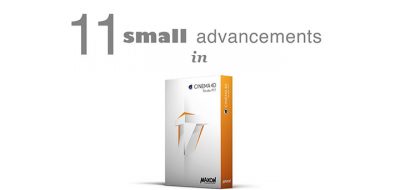Maxon has announced the latest additions to Cinema 4D in a R17 release that caries a strong focus on workflow improvements, both big and small. C4D R17 has some expanded features, while others have been completely reworked.
Major highlights for R17 included a scene and render layer management system, better animation workflows, new lens distortion support, the integration of Side FX’s Houdini Engine, and much more.
Cinema 4D R17 Take System
New to the Cinema 4D R17 release is the “Take” System, that gives you the ability to manage a scene’s render layers and animation variations.
R17’s Take System goes a step beyond a Render Layer System, offers a flexible scene management tool that allows you to create independent takes of a scene. You can easily change any parameter to create limitless variations which are saved in a single scene file. This will completely eliminate file management hassles of multiple iterated files and save on disk space.
Animation Workflow Enhancements
There have been a host of new changes in animation with Cinema 4D R17, offering a much faster and more precise animation experience. You can easily control F-Curves with weighted tangents ,with the option of automatically removing unwanted overshoot.
New Euler filtering, give you the ability to easily eliminate Gimbal lock. You can define animation regions using range markers and master animation workflow with R17’s new Timeline preferences.
Check out more details for Cinema 4D R17’s press release
FRIEDRICHSDORF, Germany – August 4, 2015 — MAXON today announced Cinema 4D Release 17 (R17), a milestone release of its cornerstone 3D animation, graphics, VFX, visualization, and rendering software. Cinema 4D R17 delivers new, expanded and completely reworked features for exceptional performance allowing creatives to more easily and efficiently manage and create outstanding content.
Cinema 4D R17 Feature Highlights
At SIGGRAPH 2015 in Los Angeles, August 11 – 13, MAXON will preview the new features in R17. Key highlights include:
Take System: Delivers new functionality above and beyond a Render Layer System to provide flexible scene management allowing artists to create numerous independent takes of a scene and change almost any parameter for intuitive variations – all saved in a single scene file, eliminating file management hassles and wasted disk space. The ability to maintain complete versioning and variation control also saves users valuable production time.
Lens Distortion Support: Easily generate a distortion profile for any image, e.g., for curved and plunging lines when integrating 3D elements into videos or photos. The intuitive interface also improves functionality to remove distortion for tracking and scene creation, re-apply distortion at render time and offers the option of saving lens settings for future use.
Graph View for Motion Tracker: R17 has a new Graph View that highlights problem track points in a simple-to-use graph and lets users easily remove them from the calculation for improved efficiency.
New Spline Tools: The completely reworked Spline Tools in R17 provide artists with added control for manipulating points, lines, tangents and arcs more intuitively. Users can leverage Boolean operators like Intersect, Subtract, Union, And, Or for an even faster workflow.
Animation Workflow Enhancements: Now artists can animate faster and with more precision in Cinema 4D R17. Simply control F-Curves with weighted tangents with the option of automatically removing overshoot. Easily eliminate Gimbal lock with Euler filtering, define animation regions using range markers and master animation workflow with new Timeline preferences.
Sculpting Improvements: MAXON introduces dozens of new features in R17 to sculpt with precision and ease. The Sculpt to Pose Morph feature automatically creates morph targets for each sculpt layer, which lets artists quickly transition from character design to character animation. The new Edge Detection feature is designed to let users easily sculpt hard-surface models.
Houdini Engine Integration: A seamless integration for Side Effect Software’s Houdini Engine lets users load Houdini Digital Assets (HDA) such as parametric objects, simulations, etc., into Cinema 4D and manipulate them like standard Cinema 4D generators. The Houdini Engine processes the HDA in the background with extremely low overheads and returns it to Cinema 4D for a highly efficient yet unobtrusive workflow.
SketchUp Integration: Tighter integration in R17 with SketchUp – a 3D modeling program for a wide range of drawing applications ranging from film and video game design to architectural and interior design – lets creative professionals quickly populate scenes by accessing free, ready-to-use objects created and made available by the SketchUp user community.
Cinema 4D R17 Pricing, Availability and Upgrade Path
Cinema 4D Release 17 is scheduled to ship September, 2015. Pricing and upgrade information is available at www.maxon.net. Available for both Mac OS X and Windows.




Gumbum
Bah. Talk about lackluster :/